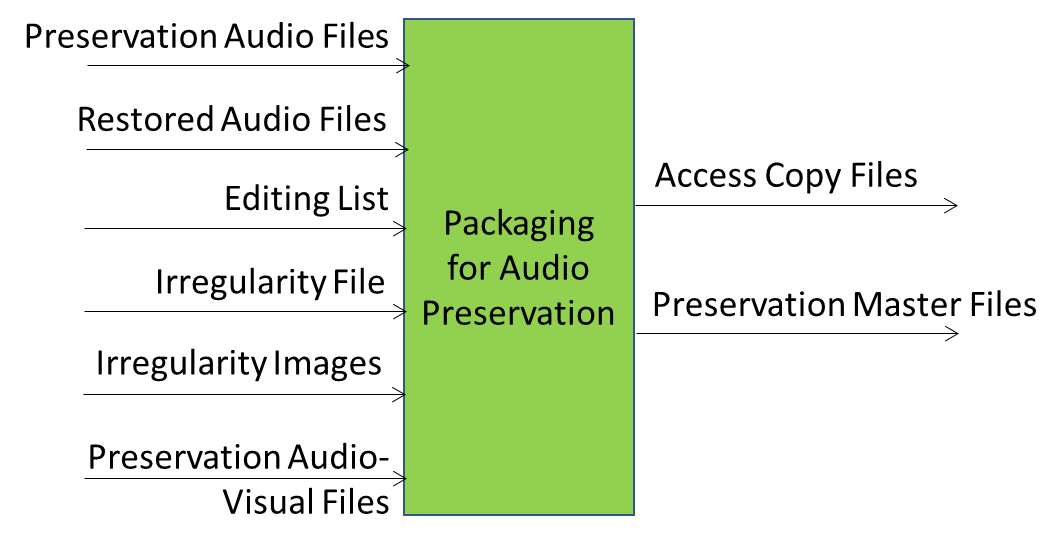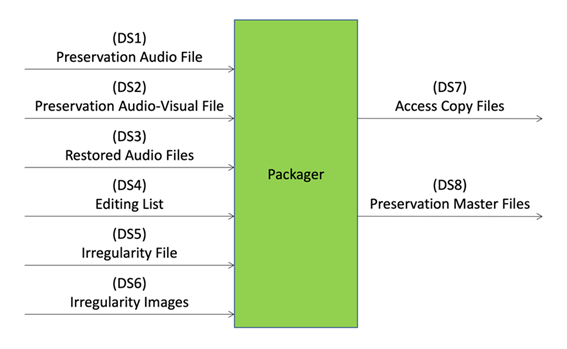| 1 Function | 2 Reference Model | 3 Input/Output Data |
| 4 SubAIMs | 5 JSON Metadata | 6 Profiles |
| 7 Reference Software | 8 Conformance Texting | 9 Performance Assessment |
1. Function
- Receives Preservation Audio File, Restored Audio Files, Editing List, Irregularity File, Irregularity Images, and Preservation Audio-Visual Files.
- Produces Preservation Master Files and Access Copy Files
2. Reference Model

Figure 1 – Reference Model of Packaging for Audio Preservation
3. Input/Output Data
| Input data | Semantics |
| Preservation Audio File | File obtained by digitising the analogue tape audio recording composed of music, soundscape or speech read from a magnetic tape. |
| Restored Audio Files | Preservation Audio File restored by Tape Audio Restoration. |
| Editing List | The list for editing the Preservation Audio File.. |
| Irregularity File | Irregularity File produced by Tape Irregularity Classification. |
| Irregularity Images | Images corresponding to the Irregularities received or detected |
| Output data | Semantics |
| Editing List | The list for editing the Preservation Audio File. |
| Restored Audio Files | Audio Files obtained by restoring the Preservation Audio File per Editing List. |
4. SubAIMs
No SubAIMs.
5. JSON Metadata
https://schemas.mpai.community/CAE1/V2.4/AIMs/PackagingForAudioPreservation.json
6. Profiles
No Profiles
7. Reference Software
The CAE-PAP Reference Software can be downloaded from the MPAI Git.
8. Conformance Testing
| Receives | Preservation Audio File | Shall validate against the Audio Object schema. The Qualifier shall validate against the Audio Qualifier schema. The values of any Sub-Type, Format, and Attribute of the Qualifier shall correspond with the Sub-Type, Format, and Attributes of the Audio Object Qualifier schema. |
| Restored Audio Files | Shall validate against the Audio Object schema. The Qualifier shall validate against the Audio Qualifier schema. The values of any Sub-Type, Format, and Attribute of the Qualifier shall correspond with the Sub-Type, Format, and Attributes of the Audio Object Qualifier schema. |
|
| Editing List | Shall validate against the Editing List schema. | |
| Irregularity File | Shall validate against the Irregularity File schema. | |
| Irregularity Images | Shall validate against the Visual Object schema. The Qualifier shall validate against the Visual Qualifier schema. The values of any Sub-Type, Format, and Attribute of the Qualifier shall correspond with the Sub-Type, Format, and Attributes of the Visual Object Qualifier schema. |
|
| Produces | Editing List | Shall validate against the Editing List schema. |
| Restored Audio Files | Shall validate against the Audio Object schema. The Qualifier shall validate against the Audio Qualifier schema. The values of any Sub-Type, Format, and Attribute of the Qualifier shall correspond with the Sub-Type, Format, and Attributes of the Audio Object Qualifier schema. |
9. Performance Assessment
Table 35 gives the Audio Recording Preservation (ARP) Packager Means and how they are used.
Table 35 – AIM Means and use of Audio Recording Preservation (ARP) Packager.
| Means | Actions |
| Performance Assessment Dataset | DS1: n Preservation Audio Files.
DS2: n Preservation Audio-Visual Files related to DS1. DS3: n Restored Audio Files arrays related to DS1 coming from Tape Audio Restoration. DS4: n Editing Lists related to DS3 coming from Tape Audio Restoration. DS5: n Irregularity Files related to DS1 coming from Tape Irregularity Classifier. DS6: n Irregularity Images related to DS5 coming from Tape Irregularity Classifier. DS7: n Access Copy Files. DS8: n Preservation Master Files. |
| Procedure | 1. Feed Packager under Assessment with DS1, DS2, DS3, DS4, DS5 and DS6.
2. Compare the output Access Copy Files with DS7. 3. Compare the output Preservation Master Files with DS8. |
| Evaluation | For a given input tuple, verify that:
1. The output Access Copy Files contain the Restored Audio Files, the Editing List, the Irregularity File and the set of Irregularity Images in a .zip file and is therefore equal to DS7. 2. The output Preservation Master Files contain the Preservation Audio File, the Preservation Audio-Visual File with the audio of the Preservation Audio File, the Irregularity File, and the Irregularity Images, and is therefore equal to DS8. An error on any of the output arrays will make the Packager under test not conformant. |

Figure 14 – Packager.
After the Assessment, Performance Assessor shall fill out Table 36.
Table 36 – Performance Assessment form of Audio Recording Preservation (ARP) Packager.
| Performance Assessor ID | Unique Performance Assessor Identifier assigned by MPAI | |||||||||||||||||||||||||||||||||||||||
| Standard, Use Case ID and Version | Standard ID and Use Case ID, Version and Profile of the standard in the form “CAE-ARP-2.40”. | |||||||||||||||||||||||||||||||||||||||
| Name of AIM | Packager | |||||||||||||||||||||||||||||||||||||||
| Implementer ID | Unique Implementer Identifier assigned by MPAI Store. | |||||||||||||||||||||||||||||||||||||||
| AIM Implementation Version | Unique Implementation Identifier assigned by Implementer. | |||||||||||||||||||||||||||||||||||||||
| Neural Network Version* | Unique Neural Network Identifier assigned by Implementer. | |||||||||||||||||||||||||||||||||||||||
| Identifier of Performance Assessor Dataset | Unique Dataset Identifier assigned by MPAI Store. | |||||||||||||||||||||||||||||||||||||||
| Assessment ID | Unique Assessment Identifier assigned by Performance Assessor. | |||||||||||||||||||||||||||||||||||||||
| Actual output | Actual output provided as a matrix of n rows containing output assertions.
Final assertion: T/F |
|||||||||||||||||||||||||||||||||||||||
| Execution time* | Duration of Assessment execution. | |||||||||||||||||||||||||||||||||||||||
| Assessment comment* | Comments on Assessment results and possible needed actions. | |||||||||||||||||||||||||||||||||||||||
| Assessment Date | yyyy/mm/dd. |
* Optional field

